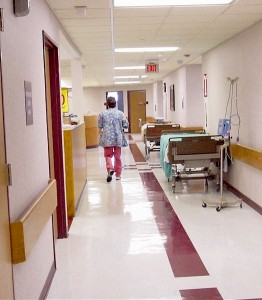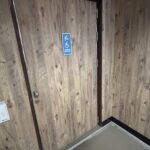This post was printed in the January 2011 issue of Doors & Hardware
[Click here to download the reprint of this article.]
A while back I wrote a post about spending time in a maternity ward, which was a completely locked unit requiring remote release from the nurses’ station to exit. Although the 2009 edition of NFPA 101 allows egress doors in certain health care occupancies to be locked, the requirements of the International Building Code are not as clear.
The 2009 edition of the IBC contains some confusing language in section 1008.1.9.6, “Special Locking Arrangements in Group I-2.” Group I-2 typically applies to hospitals, nursing homes, detoxification facilities, and mental hospitals. This section describes the requirements for locking these facilities when the clinical needs of the patients require such locking. Prior to the 2009 edition of the IBC, the most secure locking typically allowed was a delayed egress lock. Although these locks would prevent someone from exiting for 15 seconds, or 30 seconds if allowed by the AHJ, they were not appropriate for many types of facilities where the patients would constantly initiate the alarm cycle or where greater security was required.
The new section in the 2009 IBC describes locks which unlock upon actuation of the fire alarm / sprinkler system / power failure, are capable of being unlocked remotely, and can be unlocked by clinical staff at all times. Unfortunately, this section uses the term “delayed egress lock” even though it is not describing the product known in the hardware industry as a delayed egress lock. There is no requirement for a 15-second delay initiating unlocking, special signage, or a local alarm.
A change proposal (#G65) in the current code change cycle for the IBC contains revised language for this section, which was approved and will be included in the 2012 IBC. Since this is more like a clarification rather than an actual change, it helps to explain the intent of this section even though the 2012 edition may not be adopted in a project’s jurisdiction for several years.
In my opinion, this revised language allows the use of electromagnetic locks or fail safe double-cylinder electrified mortise locks that meet all of the criteria listed below. It does not require delayed egress hardware, or the motion sensor and push button typically required when electromagnetic locks are used. Free egress is not required until actuation of the fire alarm, power failure, or remote release. The staff must be trained and ready to unlock the doors as needed, the building must be protected throughout with a sprinkler / fire detection system, and emergency lighting must be provided at the door. The doors are not required to unlock upon fire alarm or power failure for certain psychiatric treatment facilities. Refer to the actual code section below for details.
Note: Because the Joint Commission is not currently enforcing the 2009 edition of the Life Safety Code, facilities must apply for a Traditional Equivalency to install locking systems allowed by more current codes. Facilities may also require a waiver from the Centers for Medicare and Medicaid Services (CMS). UPDATE: Click here to download a letter from CMS about this.
Here is the revised language planned for the 2012 edition of the IBC:
1008.1.9.6 Special locking arrangements in Group I-2. Approved special egress locks shall be permitted in a Group I-2 occupancy where the clinical needs of persons receiving care require such locking. Special egress locks shall be permitted in such occupancies where the building is equipped throughout with an automatic sprinkler system in accordance with Section 903.3.1.1 or an approved automatic smoke or heat detection system installed in accordance with Section 907, provided that the doors are installed and operated in accordance with Items 1 through 7 below.
1. The doors unlock upon actuation of the automatic sprinkler system or automatic fire detection system.
2. The doors unlock upon loss of power controlling the lock or lock mechanism.
3. The door locks shall have the capability of being unlocked by a signal from the fire command center, a nursing station or other approved location.
4. A building occupant shall not be required to pass through more than one door equipped with a special egress lock before entering an exit.
5. The procedures for the operation(s) of the unlocking system shall be described and approved as part of the emergency planning and preparedness required by Chapter 4 of the International Fire Code.
6. All clinical staff shall have the keys, codes or other means necessary to operate the locking devices.
7. Emergency lighting shall be provided at the door.
Exception: Items 1 through 4 shall not apply to doors to areas where persons which because of clinical needs require restraint or containment as part of the function of psychiatric treatment areas.
The 2009 edition of NFPA 101 contains similar language in the health care chapters:
18.2.2.2.5.1* Door-locking arrangements shall be permitted where the clinical needs of patients require specialized security measures or where patients pose a security threat, provided that one of the following criteria is met:
(1) Staff can readily unlock doors at all times in accordance with 18.2.2.2.6.
(2) The provisions of 18.2.2.2.5.2 are met.
18.2.2.2.5.2 Door-locking arrangements shall be permitted where patient special needs require specialized protective measures for their safety, provided that all of the following criteria are met:
(1) Staff can readily unlock doors at all times in accordance with 18.2.2.2.6.
(2) A total (complete) smoke detection system is provided throughout the locked space in accordance with 9.6.2.9, or locked doors can be remotely unlocked at an approved, constantly attended location within the locked space.
(3)*The building is protected throughout by an approved, supervised automatic sprinkler system in accordance with 18.3.5.1.
(4) The locks are electrical locks that fail safely so as to release upon loss of power to the device.
(5) The locks release by independent activation of each of the following:
..(a) Activation of the smoke detection system required by 18.2.2.2.5.2(2)
..(b) Waterflow in the automatic sprinkler system required by 18.2.2.2.5.2(3)
18.2.2.2.6 Doors that are located in the means of egress and are permitted to be locked under other provisions of 18.2.2.2.5 shall comply with the following:
(1) Provisions shall be made for the rapid removal of occupants by means of one of the following:
…(a) Remote control of locks
…(b) Keying of all locks to keys carried by staff at all times
…(c) Other such reliable means available to the staff at all times
(2) Only one locking device shall be permitted on each door.
From Annex A of NFPA 101 2009:
A.18.2.2.2.5.1 Psychiatric units, Alzheimer units, and dementia units are examples of areas with patients who might have clinical needs that justify door locking. Forensic units and detention units are examples of areas with patients who might pose a security threat. Where Alzheimer or dementia patients in nursing homes are not housed in specialized units, the provisions of 18.2.2.2.5.1 should not apply. (See 18.2.2.2.5.2.)
A.18.2.2.2.5.2 Pediatric units, maternity units, Alzheimer units, dementia units, and emergency departments are examples of areas where patients might have special needs that justify door locking.
This post was originally created on July 27th, 2010, and was printed in the January 2011 issue of Doors & Hardware magazine.
Click here to read an article from the January/February 2011 edition of the NFPA Journal regarding upcoming changes to NFPA 101 – The Life Safety Code which affect health care occupancies.
You need to login or register to bookmark/favorite this content.








Lori,
I just want to say thanks for this post. It certainly clarifies this code, which I have been struggling with understanding. I really appreciate your blog, your understanding of codes, and your desire to help others (especially me) learn all about them. Thanks Again!
You’re welcome, Michael!
Lori,
I recently finished reading your article in the January issue of Doors and Hardware. It was one of the best articles I’ve read on this often confusing and misunderstood item of I-2 Special Egress. I am an architect that designs senior facilities in 9 western states and I can tell you that we often have to coordinate with building officials about this topic. The addition of a back-up generator further complicates this issue!
I do find one thing that sometimes gets overlooked by hardware people. Usually these egress control doors are also fire rated doors. As such they also have to comply with self-closing and latching requirements. The self-closing usually is not a problem, but people forget that if they use mag-locks for security that mag-locks will not provide the latching function when they fail-safe.
Thanks for a great article,
John